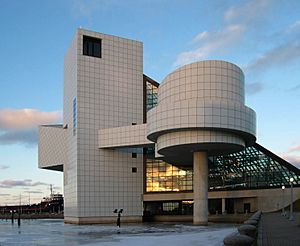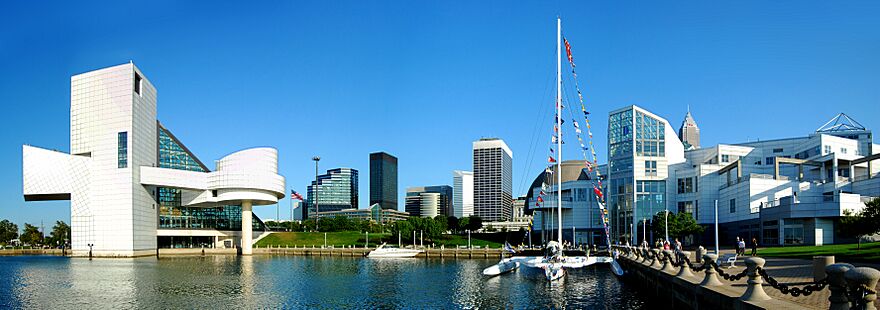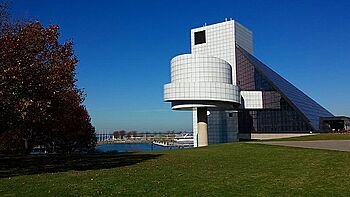Rock and Roll Hall of Fame facts for kids
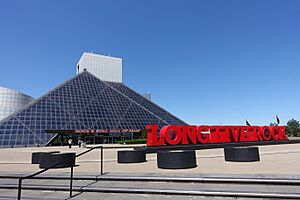
The Rock and Roll Hall of Fame in 2017
|
|
| Established | April 20, 1983 Dedicated September 1, 1995 |
|---|---|
| Location | 1100 Rock and Roll Boulevard (East 9th Street at Lake Erie) Cleveland, Ohio, U.S. 44114 |
| Visitors | 543,000 (2016) |
| Public transit access | |
The Rock and Roll Hall of Fame (RRHOF), often called the Rock Hall, is a famous museum and hall of fame in downtown Cleveland, Ohio. It sits right on the shore of Lake Erie. The museum tells the story of rock music. It honors the artists, producers, and other important people who helped shape this style of music.
The Rock and Roll Hall of Fame Foundation was started on April 20, 1983, by Ahmet Ertegun, the founder of Atlantic Records. After looking for the perfect city, Cleveland was chosen in 1986 to be the Hall of Fame's home. The famous architect I. M. Pei designed the museum building, which officially opened on September 1, 1995.
Contents
How the Hall of Fame Began
The RRHOF Foundation was created in 1983 by Ahmet Ertegun. He put together a team of music experts, including Jann S. Wenner, the publisher of Rolling Stone magazine. The Foundation started adding artists to the Hall of Fame in 1986, but it didn't have a building yet.
Several cities wanted to be the home for the museum. These included Philadelphia, Memphis, Detroit, New York City, and Cleveland.
Cleveland worked hard to be chosen. City leaders promised $65 million to help build the museum. They pointed out that a Cleveland disc jockey, Alan Freed, came up with the name "rock and roll" and promoted the music. Cleveland was also the site of the Moondog Coronation Ball, often called the first major rock and roll concert. Many famous musicians, like David Bowie and Bruce Springsteen, also started their U.S. tours in Cleveland.
The Museum Building
The ceremony to start construction happened on June 7, 1993. Rock stars like Pete Townshend, Chuck Berry, and Billy Joel were there.
The museum officially opened on September 1, 1995. Yoko Ono and Little Richard helped cut the ribbon in front of a crowd of over 10,000 people. The next night, a huge concert was held at Cleveland Stadium. It featured many music legends, including Chuck Berry, Bob Dylan, Aretha Franklin, and Bruce Springsteen.
The museum honors all of rock and roll history, not just the artists in the Hall of Fame. The official inductees are celebrated in a special wing of the building that sticks out over Lake Erie.
Inside the Museum
The building has seven levels full of amazing things to see.
- Lower Level: This is where you'll find the main gallery, the Ahmet M. Ertegun Exhibition Hall. It has exhibits on the roots of rock music, like gospel, blues, and country. It also shows how cities like Memphis, Detroit, and London were important to rock music. There are special displays for artists like the Beatles, the Rolling Stones, and Jimi Hendrix.
- First and Second Floors: The first floor is the entrance. It has a café and a stage for special performances. The second floor has fun, interactive exhibits about one-hit wonders and the "Songs That Shaped Rock and Roll."
- Third and Fourth Floors: On the third floor, you enter the Hall of Fame section. You can watch a film in the Connor Theater that shows exciting moments from past induction ceremonies. The fourth floor has another theater for special events.
- Top Floors: The top two levels have large, temporary exhibits. These exhibits change over time. In the past, they have featured Elvis Presley, the Who, U2, John Lennon, and the Rolling Stones.
A Unique Design
The building was designed by architect I. M. Pei. It is made of bold, geometric shapes, including a 162-foot tower and a glass pyramid. The design is meant to show the energy and excitement of rock and roll music.
Pei said, "I have consciously used an architectural vocabulary that is bold and new, and I hope the building will become a dramatic landmark for the city of Cleveland and for fans of rock and roll around the world."
Special Exhibits and Events
The Rock Hall is always hosting new exhibits. Some are huge and fill the top two floors, while others are smaller.
The first major exhibit in 1997 was about the Psychedelic Era of the 1960s. Another popular exhibit was all about Elvis Presley, the "King of Rock and Roll." Other exhibits have focused on hip-hop music, rock and roll fashion, and the role of women in rock.
The museum also holds many public events, like concerts, interviews, and film screenings. Every February, the museum celebrates Black History Month to show the important role African-Americans played in rock history.
Another special event is the annual American Music Masters series. Each year, this week-long celebration honors one of the Hall's inductees with concerts and other programs.
Who Gets into the Hall of Fame?
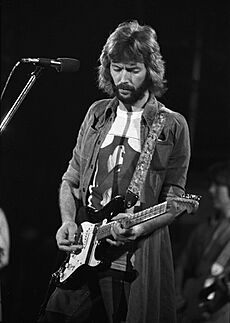

New members are added to the Rock and Roll Hall of Fame at a ceremony each year. These ceremonies often happen in New York City, but they are also held in Cleveland and Los Angeles.
The first group of artists was inducted on January 23, 1986. This group included legends like Elvis Presley, James Brown, Little Richard, Ray Charles, and Chuck Berry.
Performers
This is the main category for singers, bands, and musicians. A committee of rock and roll experts chooses a list of names. Then, about 500 people from the music industry vote for who gets in. An artist can be considered 25 years after their first record was released.
Early Influences
This category honors artists from earlier styles like blues, jazz, and country. These musicians inspired the first rock and roll artists. Honorees include Robert Johnson, Hank Williams, and Louis Armstrong.
Ahmet Ertegun Award
This award is for people who worked "behind the scenes." This includes record producers, songwriters, and music journalists. It is named after Ahmet Ertegun, one of the Hall of Fame's founders.
Award for Musical Excellence
This award honors talented musicians who played on many famous recordings but were not the main stars. These are often called session musicians or "sidemen."
Library and Archives
The Rock and Roll Hall of Fame has a Library and Archives. It is the world's largest collection of materials about rock and roll history. It is located in a separate building in Cleveland.
Here, you can read books and magazines, listen to music, and watch videos. The archives also hold special items. These include personal letters from Aretha Franklin and Madonna, and handwritten song lyrics by Jimi Hendrix.
Images for kids
See also
 In Spanish: Salón de la Fama del Rock and Roll para niños
In Spanish: Salón de la Fama del Rock and Roll para niños
- List of 200 Definitive Albums in the Rock and Roll Hall of Fame
- List of music museums
- List of Rock and Roll Hall of Fame inductees


